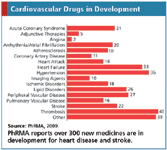Pulse on Heart Drugs
Applied Clinical Trials
Why experts predict volatile years ahead for the global cardiovascular drug market.
The cardiovascular drug market is expected to reach $116.3 billion this year. Current market research from business intelligence firm Piribo states that the global cardiovascular drug market will experience a period of high volatility from 2011 to 2015. The reasons? Key products, including blockbusters Plavix and Lovenox, are facing patent expiration. Plavix is an anti-platelet comarketed by Bristol-Myers Squibb (in the U.S.) and sanofi-aventis (rest of world). Approved in 1997, it is one of the top three best-selling drugs and had total sales of about $5.6 billion in 2008. The Plavix patent expires in 2011. Lovenox, an anticoagulant from sanofi-aventis for the treatment of acute deep vein thrombosis expires in 2012. The drug has consistently brought in on average $2.6 billion a year for sanofi-aventis since 2004, with projected sales of $3.7 billion in 2010.
Meanwhile, the patent expiration of Pfizer's Lipitor in 2011, coupled with other factors, led to its apparent exit from R&D in the cardiovascular market. Those factors included Pfizer's Phase III halting of torcetrapid due to excessive mortality (with an $800 million price tag); and a recognition that the drug blockbuster days are over and the next wave of compounds will be complex to develop, both from a regulatory and clinical standpoint.

Cardiovascular Drugs in Development
However, based on the increase in Type II diabetes and obesity in worldwide populations, the demand for cardiovascular drugs are not going to abate.
In a recent podcast interview available on our Web site, Richard Gregg, MD, Chief Scientific Officer for Vitae Pharmaceuticals, discussed the development of cardiometabolic drugs that address the constellation of issues present in this space—hyperglycemia with diabetes, lipids and blood pressure control in cardiovascular, and obesity, a co-morbidity of both diabetes and lipid disorders. Sponsors will then need to prove multiple endpoints for these drugs, cardiovascular safety and improvement, as well as either weight loss and insulin control.
For the future, he advised CROs and service providers to be prepared to provide more sophisticated biomarker and imaging studies in Phase I and Phase II to demonstrate that molecular targets are being hit, as well as being able to measure microvascular and potential safety complications.

Including Women of Childbearing Age in Clinical Research
March 26th 2024In recognition of International Women's Month, we're featuring this recent talk between Associate Editor Miranda Schmalfuhs and Marie Teil, Global Head of UCB’s Women of Childbearing Age Program. They speak about the specific challenges women with chronic illnesses face when accessing appropriate treatment and participating in clinical trials, UCB's Women of Childbearing Age Program and it’s most successful strategies, and much more.
Regulatory Compliance With eCOAs
April 26th 2024In the fourth and final part of this video interview with ACT editor Andy Studna, Melissa Mooney, director, eCOA sales engineering, IQVIA discusses how the regulatory stance on electronic clinical outcome assessments has changed over the years and what it could look like in the future.
Improving Engagement While Maintaining Data Integrity & Validity
March 19th 2024In recognition of Women's Health Month, we're featuring this recent talk between Associate Editor Miranda Schmalfuhs and uMotif's Chief Product Officer, Julia Lakeland, discuss new technologies improving patient engagement and reducing the emotional and logistical burdens of participation, ethical considerations that should be addressed when implementing those technologies, while ensuring patient privacy, and much more.
Using Patient Reported Outcomes in Dermatology Trials
April 25th 2024In part 3 of this video interview with ACT editor Andy Studna, Melissa Mooney, director, eCOA sales engineering, IQVIA sheds light on the unique challenges of dermatology trials and how clinical outcome assessments can be implemented in them.